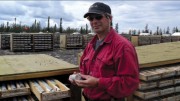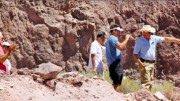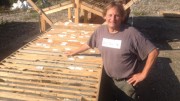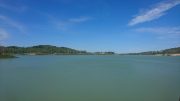JAMES BAY REGION, QUE. — On a blustery grey day in mid-October, as Stornoway Diamond (TSX: SWY) welcomes 200 visitors to the official opening of its Renard diamond mine in north-central Quebec, it’s hard not to be impressed by what president and CEO Matt Manson and his team have accomplished here.
The junior turned developer — and now producer — has consistently beat its own construction time lines and spending estimates at the mine, 360 km north of Chibougamau, and 250 km north of Mistissini. The cost to build Quebec’s first diamond mine is an estimated $775 million, which is well under the $811 million originally budgeted. It also expects to start commercial production by the end of 2016 — six months earlier than planned. All of this happened while Stornoway managed its own growth to 450 employees, from just a dozen three years ago.
Over the first 10 years of its 14-year mine life, Renard could produce 1.8 million carats of diamonds a year — contributing 1.5–2% of global production. A March 2016 mine plan pegs Renard’s net present value at $974 million.
With a remote mine, infrastructure is everything, and it’s clear that Stornoway’s partnerships with the local Cree communities and the provincial government have been central to its success.
From the Clarence & Abel Swallow airport — named after two elder members of the Swallow family, the original “tallymen,” or stewards of the land upon which Renard sits — to the road that connects Renard to Chibougamau, it’s evident that the remote mine would have faced severe economic hurdles without the vital infrastructure, which was made possible by those positive relationships.
“It’s true, mines really are made, not discovered. And this mine was made,” Manson told invited guests at the official opening reception on Oct. 19.
“We’re here today to announce the opening of the first diamond mine in Quebec,” Manson told his guests. “But it’s been 20 years of hard work to get here.”
That hard work started with the project’s original owners — Ashton Mining of Canada and provincial agency Soquem — which found the first kimberlites at Renard in 2001, after five years of grassroots exploration (several guests who had been involved in the project early on were in attendance).
Stornoway acquired Ashton’s interest in Renard in 2006, after first merging with Contact Diamond, which was a subsidiary of Agnico Eagle Mines (TSX: AEM; NYSE: AEM) run by Manson. The mergers were orchestrated by Manson, who recognized Renard’s potential, Stornoway chairman and former Agnico executive Ebe Scherkus noted.
From there, work started on a feasibility study for the project in 2010. Stornoway bought Soquem’s 50% interest in the project in 2011, securing 100% of Renard. From 2012–2014, Manson and his team tried to negotiate a nearly $1-billion financing in one of the worst times in recent history for mining capital, which made things a little tougher for the company. A junior with a $120-million market cap at the time, Stornoway was also trying to raise the funds on its own, since all the other diamond mines in Canada are wholly or partly owned by multinationals.
But the company prevailed, and in April 2014, Stornoway announced it had landed a $944-million financing — the largest ever for a publicly listed diamond company. The complex deal included debt, equity and streaming components, and funding from the Quebec government, institutional and private equity, and an equipment manufacturer.

Stornoway Diamond’s Renard diamond mine in Quebec. Photo by Alisha Hiyate.
Plan Nord
As a junior trying to advance a remote diamond mine, Stornoway has cleared a lot of hurdles to get Renard built. But the company has had good luck as well. For example, without the provincial Plan Nord strategic infrastructure program — initiated by the former Jean Charest government in 2011 to encourage resource development in far reaches of the province — the economic hurdles to build Renard might have been insurmountable.
Under Plan Nord, a 240 km road linking Chibougamau to Renard was built, making Renard the first and only diamond mine in Canada with all-weather road access. Construction by the provincial Ministry of Transportation began in Feburary 2012, with Stornoway completing the last 100 km in September 2013.
“We wouldn’t have been able to build this mine without a road,” Manson acknowledged.
One of the objectives of Plan Nord is to develop resources to benefit all Québecois, Quebec Minister of Energy and Natural Resources Pierre Arcand noted at the reception.
“The Renard project is an extraordinary example of the vision that we had as a government,” Arcand said. The mine, he continued, has been “a partnership with passionate developers, involved communities and a government that helped [develop] the project.”
The Quebec government owns a 29% interest in Stornoway through Investissement Québec, the parent of Soquem.
‘Ahead of schedule’
Construction of the road and mine site over the past two years has gone remarkably well, with both projects ahead of schedule and below budget.
“I used to joke that it was a drinking game — whenever I said ‘ahead of schedule and below budget’ you’d have to take a drink,” Manson told the crowd.
The company estimates that Renard’s price tag will come in at $775 million, compared to $811 million as budgeted.
Manson gave credit for that to chief operating officer Patrick Godin. Ironically, the deprived financial situation of the mining sector over the past few years has also helped. Stornoway had little competition for the best contractors and no wait time for equipment while it was building Renard, because it was the only mine being built in eastern Canada.
In addition, the decline in the Canadian dollar worked to Stornoway’s advantage: half of Stornoway’s financing was done in U.S. dollars at a time when the Canadian dollar was US92¢.
As a result, at the end of June, the company estimated it had $197 million in financing capacity (cash, available credit, etc.). Stornoway has $249 million in debt.
The nine-month ramp-up of the processing plant is also off to a good start. The plant saw first ore in July, 10 weeks ahead of schedule, and Stornoway expects to be in commercial production by year-end — six months ahead of schedule. Commercial production at the 6,000-tonne-per-day plant is defined as the plant running at 60% of capacity for 30 consecutive days.
And the company’s first diamond sale is slated for November — two months earlier than anticipated.
However, Stornoway’s management is aware that it still has some distance to go to show Renard is a viable operation.
“Everyone’s conscious that we’ve had a very good build, we had a successful financing, we’ve had very good construction — ahead of schedule and below budget,” Manson told Diamonds in Canada magazine ahead of the mine opening. “But the job’s not done until we’ve demonstrated the potential of the project as an operating mine, and that’s a ramp-up process.”
In September, the plant was running at an average 30% capacity, with a peak processing rate of 3,130 tonnes per day, or 52% of capacity. The plant is powered by liquid natural gas rather than diesel generators (a first for a Canadian mine), and should reach full production in mid-2017.
Manson stressed that it would take many months of production to compare actual production to the forecasts of its feasibility study and updated mine plan from March 2016.
“To reconcile against our expected dollar revenue, we’ve got to reconcile [tonnage], grade, size distribution and quality of diamonds,” he says. “And then we’re selling these diamonds in a market that goes up and down on a monthly basis — which is a fifth variable on what dollars we get. So we’re at the beginning of understanding what this mine is going to produce.”
Production guidance for 2016 is 220,000 carats, and for 2017, 1.7 million carats.
Renard hosts probable reserves of 22.3 million carats (33.4 million tonnes grading 67 carats per hundred tonnes).
The company has mined more kimberlite than expected because of greater volumes of high-grade, hypabyssal kimberlite in country-rock breccia material.
“It turns out the hypabyssal kimberlite is in there in big 5- to 10-metre wide blocks that we can mine selectively,” Manson said. “So rather than send that material to a low-grade stockpile, it has been going to the high-grade stockpile.”
Whether or not the surprise extra ore affects overall grades remains to be seen.
Another sweetener for Stornoway could be a large diamond population at Renard 2. The plant includes a large diamond recovery TOMRA XRT unit to avoid breaking larger stones that may be recovered. The size distribution of samples from the Renard 2 kimberlite suggest the potential to recover three to six diamonds between 50 and 100 carats, and one to two stones greater than 100 carats for every 100,000 carats produced.
With plenty of ore in the stockpiles from Renard 2 and 3, the primary production bottleneck is in the plant, and the company is tweaking its process for dewatering kimberlite for disposal in dry-stack tailings.
Until 2018, when the underground ramp to access Renard 2 and Renard 3 is completed, Renard will be a wholly open-pit operation. In addition to going underground in 2018, the company plans to expand the plant to 7,000 tonnes per day to handle underground ore at Renard 2, as well as open-pit ore from R65.
Diamond market
While the diamond market had a bad year in 2015, with demand slowing in China, 2016 has seen a bit of a comeback in prices and demand for rough stones.
“Diamonds are a unique product. They’re sold to commemorate the most important emotional moments in your life — anniversaries, engagements, daughters graduating from college — that is a marvellously cross-cultural, cross-demographic business,” Manson told reporters on-site. “There’s great stability in the diamond business … we don’t have any concerns on that front at all.”
In any event, Renard’s economics are robust and appear resilient to weaker prices. In the company’s updated mine plan in March 2016, it used modelled prices of US$155 per carat, which is 19% lower than in March 2014, Manson pointed out.
“We still had a 58% operating margin after tax and after stream based on those reduced prices,” he said.
Life-of-mine operating costs are projected at $56 per tonne, or $84.37 per carat.
At press time, Stornoway shares traded at $1.10 in a 52-week range of 66¢ to $1.33.






Be the first to comment on "Stornoway opens Quebec’s first diamond mine"